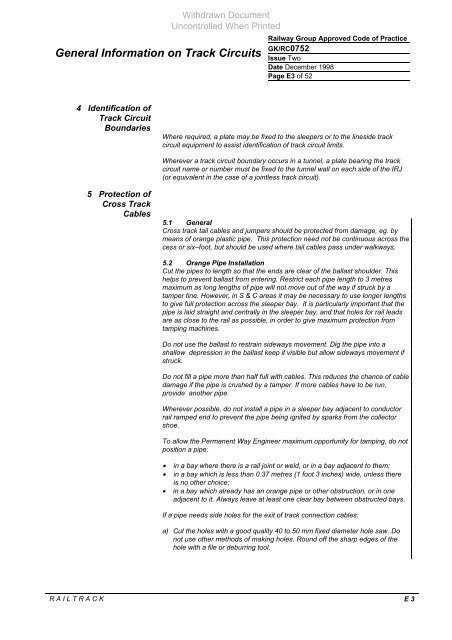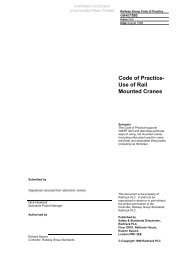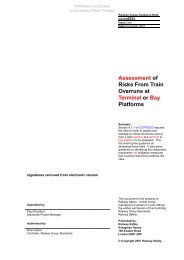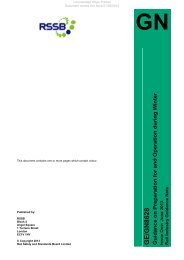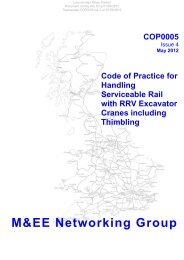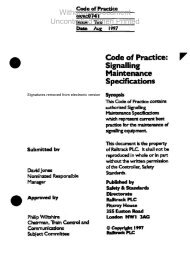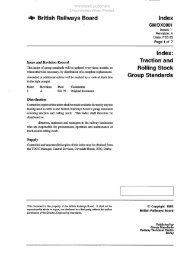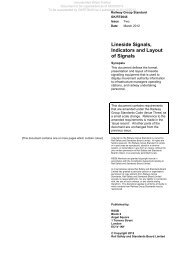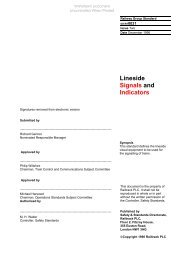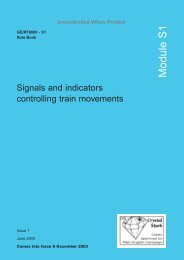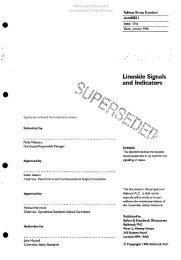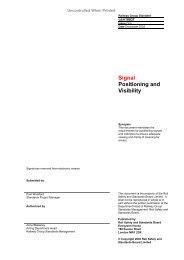General Information on Track Circuits - RGS Online
General Information on Track Circuits - RGS Online
General Information on Track Circuits - RGS Online
You also want an ePaper? Increase the reach of your titles
YUMPU automatically turns print PDFs into web optimized ePapers that Google loves.
<str<strong>on</strong>g>General</str<strong>on</strong>g> <str<strong>on</strong>g>Informati<strong>on</strong></str<strong>on</strong>g> <strong>on</strong> <strong>Track</strong> <strong>Circuits</strong><br />
Railway Group Approved Code of Practice<br />
GK/RC0752<br />
Issue Two<br />
Date December 1998<br />
Page E3 of 52<br />
4 Identificati<strong>on</strong> of<br />
<strong>Track</strong> Circuit<br />
Boundaries Where required, a plate may be fixed to the sleepers or to the lineside track<br />
circuit equipment to assist identificati<strong>on</strong> of track circuit limits.<br />
5 Protecti<strong>on</strong> of<br />
Cross <strong>Track</strong><br />
Cables<br />
Withdrawn Document<br />
Unc<strong>on</strong>trolled When Printed<br />
Wherever a track circuit boundary occurs in a tunnel, a plate bearing the track<br />
circuit name or number must be fixed to the tunnel wall <strong>on</strong> each side of the IRJ<br />
(or equivalent in the case of a jointless track circuit).<br />
5.1 <str<strong>on</strong>g>General</str<strong>on</strong>g><br />
Cross track tail cables and jumpers should be protected from damage, eg. by<br />
means of orange plastic pipe. This protecti<strong>on</strong> need not be c<strong>on</strong>tinuous across the<br />
cess or six–foot, but should be used where tail cables pass under walkways.<br />
5.2 Orange Pipe Installati<strong>on</strong><br />
Cut the pipes to length so that the ends are clear of the ballast shoulder. This<br />
helps to prevent ballast from entering. Restrict each pipe length to 3 metres<br />
maximum as l<strong>on</strong>g lengths of pipe will not move out of the way if struck by a<br />
tamper tine. However, in S & C areas it may be necessary to use l<strong>on</strong>ger lengths<br />
to give full protecti<strong>on</strong> across the sleeper bay. It is particularly important that the<br />
pipe is laid straight and centrally in the sleeper bay, and that holes for rail leads<br />
are as close to the rail as possible, in order to give maximum protecti<strong>on</strong> from<br />
tamping machines.<br />
Do not use the ballast to restrain sideways movement. Dig the pipe into a<br />
shallow depressi<strong>on</strong> in the ballast keep it visible but allow sideways movement if<br />
struck.<br />
Do not fill a pipe more than half full with cables. This reduces the chance of cable<br />
damage if the pipe is crushed by a tamper. If more cables have to be run,<br />
provide another pipe.<br />
Wherever possible, do not install a pipe in a sleeper bay adjacent to c<strong>on</strong>ductor<br />
rail ramped end to prevent the pipe being ignited by sparks from the collector<br />
shoe.<br />
To allow the Permanent Way Engineer maximum opportunity for tamping, do not<br />
positi<strong>on</strong> a pipe:<br />
• in a bay where there is a rail joint or weld, or in a bay adjacent to them;<br />
• in a bay which is less than 0.37 metres (1 foot 3 inches) wide, unless there<br />
is no other choice;<br />
• in a bay which already has an orange pipe or other obstructi<strong>on</strong>, or in <strong>on</strong>e<br />
adjacent to it. Always leave at least <strong>on</strong>e clear bay between obstructed bays.<br />
If a pipe needs side holes for the exit of track c<strong>on</strong>necti<strong>on</strong> cables:<br />
a) Cut the holes with a good quality 40 to 50 mm fixed diameter hole saw. Do<br />
not use other methods of making holes. Round off the sharp edges of the<br />
hole with a file or deburring tool.<br />
R A I L T R A C K E 3


